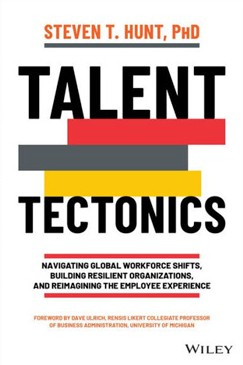
With all the challenges of finding, hiring, and keeping the right employees these days, it is important that you provide them an opportunity to develop a career path in your company and keep them engaged in and passionate about their work.
This means walking in their shoes and looking at things from their point of view. What would engage employees? What would make them enthusiastic about their work? What kind of company mission would inspire them?
The book, Talent Tectonics: Navigating Global Workforce Shifts, Building Resilient Organizations and Reimagining Employee Experience, focuses on:
- The forces that are reshaping work and workforces
- Activities that large companies need technology to do
- Organizational design that impacts the employee experience
- Elements of the employee experiences that promote learning and growth
Instead of talking about job descriptions, which traditionally have focused on what the employer wants rather than on what employees need to be successful, author Steven Hunt comes up with the idea of “job design” to maximize employee experience. Job design centers on the purpose of the job, with whom the employee works, and when and where people work. Other considerations include:
- How does the job support employee development?
- What resources are employees provided? What additional benefits or perks are offered?
- What career advancement opportunities are available to employees?
- Why do people join organizations?
Hunt addresses how job design affects the employee experience from the design of groups, teams, and departments to management structures and leadership. He also discusses a topic I find vitally important: How to manage restructuring and downsizings with experience in mind.
“Given the risks, companies should not downsize unless it is absolutely necessary,” he writes. “Downsizing decisions should not be based solely on job titles, salaries, and demographics. They should also consider employee skills, experience, relationships, and capabilities. If it is necessary to reduce the size of the workforce, it is better to do one large reduction rather than several small ones.”
With all of the difficulties we are experiencing in finding the right people, we should certainly tread very carefully when it comes to letting go employees.
Finally, the book discusses promoting personal growth. Employees want to learn and grow in the future. Elements of employee experience that play a critical role in doing that:
- Context: Design jobs that encourage and enable development by giving employees the time, the opportunity, and motivation to build new capabilities.
- Capabilities: Help employees identify what knowledge, skills, and experiences to develop to achieve their goals and prepare for the next chapter of their careers.
- Content: Provide employees with access to development resources they need to build new capabilities.
- Culture: Create an organizational environment that supports employee development, particularly the role that managers play in supporting employee development.
Hunt stresses that technology has the potential to create a future in which people no longer worry about having to work for a living. Instead, people will focus on living a fulfilling, purposeful life that includes work. What matters is how we choose to use it. Let us choose wisely.
With its very timely advice, Talent Tectonics is one of those books that you need to put on your bookshelf and keep there to read again and again.
Title: Talent Tectonics: Navigating Global Workforce Shifts, Building Resilient Organizations and Reimagining Employee Experience
Author: Steven T. Hunt, PhD
Copyright: 2022 by John Wiley & Sons
Price: $26.25 hardcover/$18 Kindle
Pages: 320 pages
